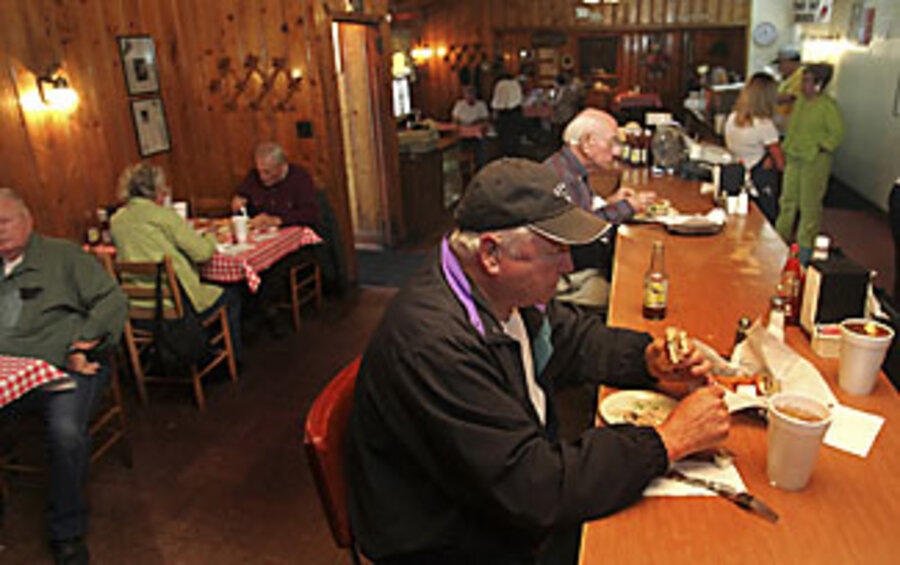Barbecue, North Carolina style
Loading...
Spend enough time in certain parts of the United States and you get the distinct impression that barbecue is a lot like religion. While all barbecue involves the cooking of meat over a fire, this most primal form of cooking has fractured into a multitude of sects and splinter groups, and even the most ecumenical devotees tend to be loyal to one form of barbecue above all others.
Then again, maybe barbecue is more like college football. Good or bad, folks tend to love the 'cue they grew up with, whether it's ribs in Kansas City, beef brisket in Texas, or a pulled pork sandwich topped with coleslaw in South Carolina.
"It's a local sport to argue about barbecue," says Dale Volberg Reed, a writer in Chapel Hill, N.C. "People grow up with loyalties to colleges. They grow up with loyalties to barbecue. And they have a hard time switching."
For Ms. Reed and her husband, John Shelton Reed, real barbecue is that which is practiced in North Carolina. They've written a book devoted to the subject, "Holy Smoke: The Big Book of North Carolina Barbecue," written with William McKinney. While the part-cookbook-part-manual may not spark waves of apostasy in other centers of American "barbeculture," its many recipes, along with a wealth of history, lore, photographs, and illustrations, make it a worthy addition to the groaning shelf of works on barbecue – and an excellent guide to the Tar Heel state's distinctive interpretation of a great American cooking style.
What exactly is North Carolina barbecue? To begin, say the authors, it's not simply whatever happens to be served up within the state's borders and called barbecue. Nor is it ribs, brisket, lamb, sausage, or chicken.
"We do all those things," says John Reed, then adds with a laugh, "We just don't think of them as barbecue."
The real thing is pretty simple. It's pork, cooked slowly for a long time at a low temperature over a hardwood fire, served with a thin sauce, or "dip," made with vinegar, red pepper, salt, sometimes tomato, and not much else.
North Carolina barbecue is composed of two major sects. Practitioners in the east primarily cook whole hogs and use a vinegar-based sauce. Those in the central part of the state, the Piedmont region, have generally forsaken cooking the whole hog in favor of just the shoulder and have embraced adding some tomato to the sauce. These seemingly small differences have sparked a good deal of intrastate wrangling, but, as the authors point out, the two styles of cooking are more like each other than either is like what you'd find elsewhere in the country. Anyway, the feud is almost as good as the food.
Among the many useful recipes included in the book are instructions for cooking a whole hog. The authors suggest getting a "dressed" hog, meaning that the whole hog isn't entirely whole, but has had some parts removed – like the feet, tail, innards – and the bristles scraped off. They recommend cooking a hog with a dressed weight no greater than 120 pounds. Bigger than that and the meat can be tough.
Cooking a whole hog is tricky business, which John describes as "an art." You have to be careful to spread the coals around in such a way as to get the hams and shoulders cooked through without burning the ribs. For those not yet ready to tackle a 100-pound beast, the authors recommend cooking a pork shoulder or "Boston butt" (the top part of the shoulder). At 7 pounds, it's a lot more manageable for the home cook. It doesn't require two people to turn and cooks through in about eight hours instead of 12.
The authors are strong advocates of cooking over hardwood (hickory and oak are preferred) to enhance the flavor. While they give their blessing to the use of charcoal by the home cook who isn't up to splitting wood and burning the chunks down to coals, they draw the line at the use of gas or electricity.
In North Carolina, even the side dishes can spark rivalry. "Holy Smoke" describes competing versions of coleslaw – made with mayonnaise in the east and vinegar in the Piedmont. The book also covers corn bread, hush puppies, Brunswick stew (a kind of hunter's stew made of whatever meat and vegetables are handy), greens, baked beans, and recipes for such non-canonical sides as macaroni and cheese, sweet corn soufflé, and Brussels sprouts with bacon.
A chapter on desserts includes recipes for traditional cobblers and banana pudding. Their Krispy Kreme bread pudding, made with nine day-old Krispy Kreme doughnuts, puts a contemporary and decidedly Southern spin on an old, possibly ancient, dish.
As for dining at barbecue joints, "Holy Smoke" offers guidance on spotting a good one, should you prefer to let others do the cooking. Billowing smoke and a pile of wood outside a barbecue restaurant is an excellent sign, but avoid places with valet parking and a menu that takes longer to read than the meal does to eat. A full parking lot is also highly desirable, particularly if it displays a healthy mix of pickup trucks and expensive imports. "If the sheriff's car is there, hit your breaks immediately," advises the book.
Curiously, none of the authors are natives of the Old North State, though they have the zeal of the convert. Both Reeds grew up in eastern Tennessee, but have lived in North Carolina since the late 1960s. McKinney is from South Carolina, but founded the Carolina Barbecue Society as a student at the University of North Carolina at Chapel Hill. As to the eastern versus Piedmont, tomato versus no-tomato, whole hog versus shoulder rivalry, they argue that their out-of-state origins give them a measure of impartiality and they have not pledged allegiance to one style over the other.
"We're above it," says Dale.
"Yes," agrees John. "We want to sell books to everybody."






